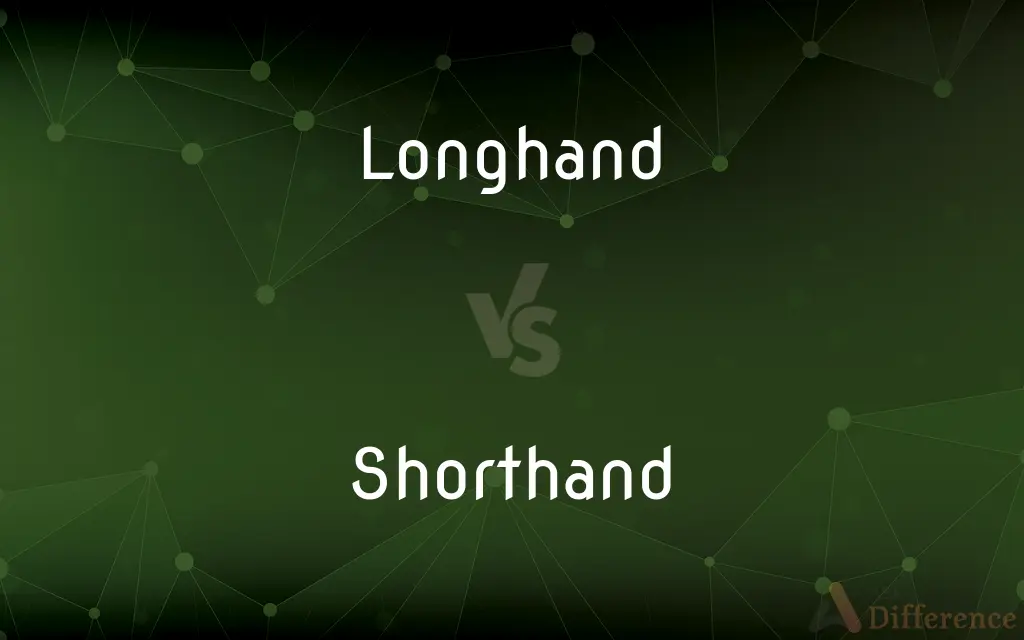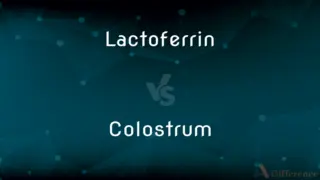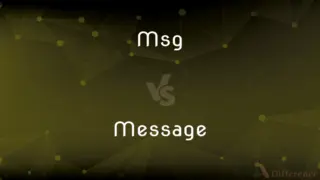Longhand vs. Shorthand — What's the Difference?
Edited by Tayyaba Rehman — By Fiza Rafique — Updated on March 9, 2024
Longhand involves writing words and letters in their full form, while shorthand uses symbols or abbreviations to represent words or phrases, making it faster for note-taking.

Difference Between Longhand and Shorthand
Table of Contents
ADVERTISEMENT
Key Differences
Longhand writing is the traditional method of writing where each word is written out completely using the full alphabet. This method is used for clarity and is the standard for most written communications, such as books, documents, and letters. On the other hand, shorthand is a writing system that uses symbols or abbreviations to represent words or phrases, allowing for quicker writing speed. It is often used in note-taking, journalism, and transcription to keep up with speech in real-time.
While longhand is widely taught and used from a young age in educational systems, shorthand requires specific training. Shorthand systems, such as Gregg or Pitman, have their own set of symbols and rules that must be learned to achieve proficiency. Whereas, anyone who learns the alphabet can write in longhand without needing specialized training.
Longhand writing is considered more accessible and readable for the general population. In contrast, shorthand, due to its use of symbols and abbreviations, is readable only to those who have learned the specific system used to take the notes. This can make shorthand notes highly personal or confidential.
In terms of speed, shorthand has a significant advantage over longhand. A proficient shorthand writer can double or even triple their writing speed, capturing speech almost in real-time. This makes shorthand particularly valuable in settings like court reporting or live broadcasting, while longhand remains preferred for most academic and professional written work due to its clarity and universality.
Technology has impacted both forms of writing differently. Typing and voice recognition software have reduced the need for shorthand in professional settings, as they offer alternative ways to quickly capture spoken words. Conversely, longhand writing has seen a resurgence in personal settings, with many people finding value in the tactile and thoughtful process of writing by hand for notes, journals, or letters.
ADVERTISEMENT
Comparison Chart
Form
Full words and letters
Symbols and abbreviations
Speed
Slower, depends on writer's skill
Faster, designed for speed
Learning Requirement
Basic literacy
Specialized training
Readability
Universal, with literacy
Restricted to those trained in the system
Use Cases
General writing, formal documentation
Note-taking, transcription, journalism
Compare with Definitions
Longhand
Writing system using the full forms of letters and words.
She wrote her essay in longhand to practice her penmanship.
Shorthand
A method of rapid writing by using symbols and abbreviations.
Reporters often use shorthand to keep up with speeches.
Longhand
Traditional method of handwritten communication.
His longhand was so elegant, it looked like calligraphy.
Shorthand
Requires learning specific systems, like Gregg or Pitman.
She took a course in Gregg shorthand to improve her note-taking.
Longhand
The standard writing style taught in schools.
Students are required to submit their assignments in longhand.
Shorthand
Useful in professions requiring fast transcription of spoken words.
Court reporters rely on shorthand to capture trial dialogue accurately.
Longhand
Used for clarity and formality in documents.
Official documents are often drafted in longhand before typing.
Shorthand
Enables faster writing speeds compared to longhand.
Using shorthand, he could transcribe the entire lecture.
Longhand
Reflects the individual's style and personality.
Her longhand revealed a meticulous and careful nature.
Shorthand
Notes can be personal and hard for others to read.
His shorthand notes were indecipherable to anyone but him.
Longhand
Cursive writing.
Shorthand
Shorthand is an abbreviated symbolic writing method that increases speed and brevity of writing as compared to longhand, a more common method of writing a language. The process of writing in shorthand is called stenography, from the Greek stenos (narrow) and graphein (to write).
Longhand
The written characters used in the common method of writing; opposed to shorthand, or typing or printing; handwriting.
Shorthand
A system of rapid handwriting employing symbols to represent words, phrases, and letters.
Longhand
Written by hand in normal characters, as opposed to shorthand.
Shorthand
A system, form, or instance of abbreviated or formulaic reference
"The classical error is to regard a scientific law as only a shorthand for its instances" (Jacob Bronowski).
Longhand
Written by hand (with pen or pencil), rather than printed out; handwritten.
I had to write the essay out twice longhand – they wouldn’t let me print it out. It took forever!
Shorthand
A rough and rapid method of writing by substituting symbols for letters, words, etc.
Longhand
The written characters used in the common method of writing; - opposed to shorthand; as, took it down in longhand.
Shorthand
(by extension) Any brief or shortened way of saying or doing something.
The jargon becomes a shorthand for these advanced concepts.
Longhand
Rapid handwriting in which letters are set down in full and cursively connected within words without lifting the writing implement from the paper
Shorthand
(transitive) To render (spoken or written words) into shorthand.
Longhand
Having words written out in full by hand;
Longhand writing
Shorthand
To use a brief or shortened way of saying or doing something.
Shorthand
(intransitive) To write in shorthand.
Shorthand
A compendious and rapid method or writing by substituting characters, abbreviations, or symbols, for letters, words, etc.; short writing; stenography. See Illust. under Phonography.
Shorthand
A method of writing rapidly
Shorthand
Written in abbreviated or symbolic form;
Shorthand notes
Common Curiosities
How much faster is shorthand compared to longhand?
Shorthand can be 2 to 3 times faster than longhand, depending on the proficiency of the writer.
Is longhand writing obsolete?
No, longhand writing is still widely used for formal documentation, personal notes, and in educational settings.
Why is shorthand used?
Shorthand is used for faster writing, allowing note-takers to keep up with rapid speech.
Can anyone learn to read shorthand?
Reading shorthand requires learning the specific system used, so it is not universally readable like longhand.
Are there different types of shorthand?
Yes, there are several shorthand systems, including Gregg and Pitman, each with its own symbols and rules.
Can shorthand be typed?
Yes, stenotype machines allow for shorthand typing, used in court reporting and closed captioning.
Is longhand or shorthand better for note-taking?
The choice depends on the individual's needs; shorthand is faster, but longhand is more universally understandable.
What is longhand writing?
Longhand writing is the process of writing words and letters in their full, traditional forms.
Can shorthand improve writing speed for everyone?
Shorthand can significantly improve writing speed, but it requires dedicated learning and practice.
Why might someone prefer longhand for personal notes?
Many find longhand to be more reflective and personal, offering a tactile and thoughtful writing experience.
Do professionals still use shorthand?
Yes, professions like court reporting and journalism may still use shorthand, though its use has declined with technology advances.
How long does it take to learn shorthand?
Learning shorthand to a proficient level typically requires months of study and practice.
Is there a digital version of shorthand?
Digital shorthand systems exist, especially for stenography, but traditional shorthand is still taught.
Is shorthand considered a form of code?
While not a code in the cryptographic sense, shorthand is a symbolic system that requires knowledge to interpret.
Can shorthand notes be translated back to longhand?
Yes, with proficiency in the shorthand system used, notes can be accurately translated back to longhand.
Share Your Discovery

Previous Comparison
Lactoferrin vs. Colostrum
Next Comparison
Msg vs. MessageAuthor Spotlight
Written by
Fiza RafiqueFiza Rafique is a skilled content writer at AskDifference.com, where she meticulously refines and enhances written pieces. Drawing from her vast editorial expertise, Fiza ensures clarity, accuracy, and precision in every article. Passionate about language, she continually seeks to elevate the quality of content for readers worldwide.
Edited by
Tayyaba RehmanTayyaba Rehman is a distinguished writer, currently serving as a primary contributor to askdifference.com. As a researcher in semantics and etymology, Tayyaba's passion for the complexity of languages and their distinctions has found a perfect home on the platform. Tayyaba delves into the intricacies of language, distinguishing between commonly confused words and phrases, thereby providing clarity for readers worldwide.
















































